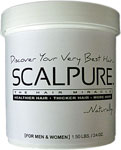I just had an epiphany regarding why minoxidil may not work for the majority of men. I would like your expert opinion on this. I think I may have just discovered something.
I have been using minoxidil for about a year along with an herbal shampoo containing all natural ingredients. I recently switched to a fancy shampoo that has many other ingredients, including dimethicone and various other ingredients that are commonly used in most shampoos to improve texture and increase thickness.
I noticed, after using this newer shampoo, that when I applied the minoxidil, it beaded up on my scalp. I immediately realized that dimethicone is a form of silicone. After reading the label of the shampoo and the matching conditioner, I noticed that they also contained other silicone-based ingredients. The ingredients are used in almost all shampoos and conditioners to coat the hairs, to add shine and improve the texture, etc.
As you may know, silicone is also the primary ingredient in auto polish, car wax and many other similar products. Silicone adds a layer of protection to surfaces and protects them. It causes water to bead up on a car’s paint, etc. This is why I noticed, I’m sure, the minoxidil beading up on my scalp after using the shampoo and conditioner containing the dimethicone. If silicone can cause water to bead up on a car’s paint, I’m sure it can also cause minoxidil to bead up on one’s scalp. It certainly appears to have that effect. If it’s beading up, I’m sure it isn’t properly penetrating. No penetration = no results!
So … here is my epiphany. We all know that minoxidil does NOT work for the majority of men. And if it does, it usually only works minimally. Now, since the majority of shampoos and conditioners contain dimethicone and similar ingredients, which prevent or hinders the penetration of minoxidil, couldn’t this be the reason why most men do not respond to minoxidil? Furthermore, there is a small percentage of men known as “responders.” These are men who respond very well to minoxidil. Maybe the reason they respond so well is something so simple that it has been overlooked, i.e., they are simply the ones using dimethicone/silicone-free hair products allowing the minoxidil to actually penetrate and do its job unhindered.
What do you think? Has this been addresssed before? If not, do you think my “theory” has any merit? I really think it does. Let me know what you think.

It is an interesting theory, but the dimethicone in the shampoo should not block the absorption of minoxidil, unless perhaps you leave the shampoo on your scalp without rinsing. You should apply minoxidil after you wash off any shampoo and conditioner and the scalp is warm from the hot shower you take, with the scalp pores open. That is when the absorption occurs.


 Vitamins are great, and products that can strengthen hair or make it healthier are good… but they have
Vitamins are great, and products that can strengthen hair or make it healthier are good… but they have  This is a new one to me. I enjoy when readers bring products to my attention, and it seems like a new unproven hair loss product is available every day. And just like many of these unproven products, Scalpure claims to be a “natural” and “breakthrough” treatment. The ingredients listed do not seem to be anything breakthrough: various oils and apple cider vinegar, none of which are likely to do anything for treating genetic hair loss. The makers claim that it pulls DHT out of the scalp like a magnet, but offers no proof of this. I don’t want to call it a “con”, but here is what it seems to be offering — buzzwords. What does it lack? Science and proof.
This is a new one to me. I enjoy when readers bring products to my attention, and it seems like a new unproven hair loss product is available every day. And just like many of these unproven products, Scalpure claims to be a “natural” and “breakthrough” treatment. The ingredients listed do not seem to be anything breakthrough: various oils and apple cider vinegar, none of which are likely to do anything for treating genetic hair loss. The makers claim that it pulls DHT out of the scalp like a magnet, but offers no proof of this. I don’t want to call it a “con”, but here is what it seems to be offering — buzzwords. What does it lack? Science and proof.
 Well, it certainly is fitting that this iPhone application shows up on Network World’s “most idiotic” list. It also shows up on Fortune Magazine’s
Well, it certainly is fitting that this iPhone application shows up on Network World’s “most idiotic” list. It also shows up on Fortune Magazine’s  Here’s what I just learned from Wikipedia —
Here’s what I just learned from Wikipedia —